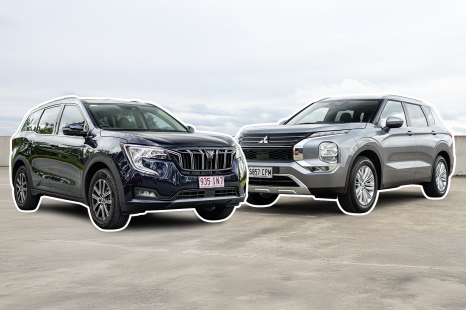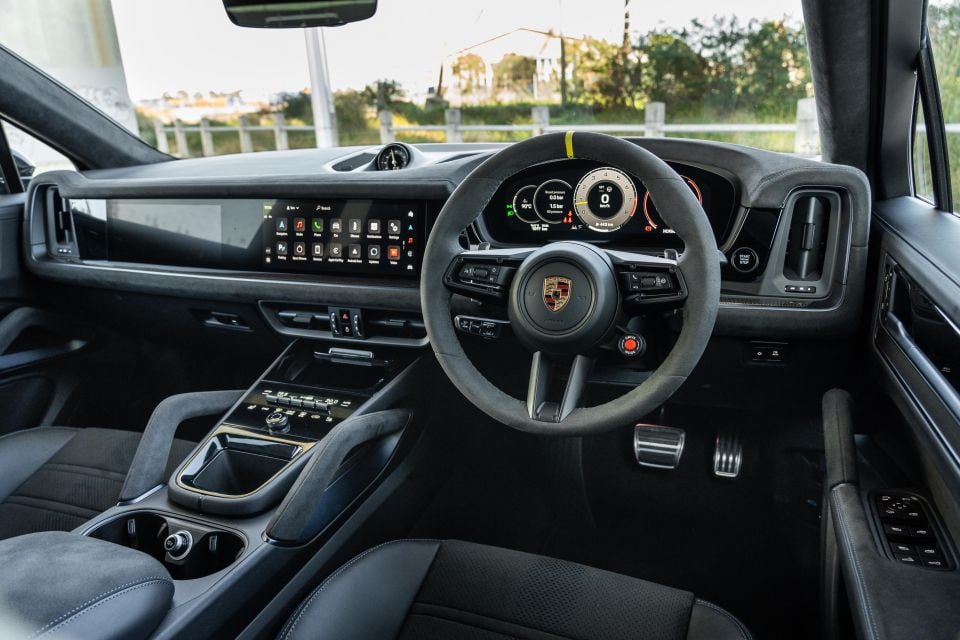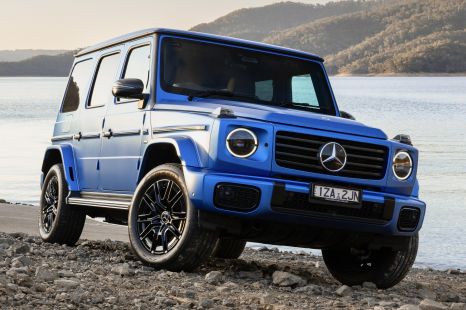

Andrew Maclean
4 Days Ago
The flagship Cayenne means business. While you may never test its limits on a public road it's a proper performance car for the whole family.



Quickly see how this car stacks up against its competition. Select any benchmark to see more details.
Take advantage of Australia's BIGGEST new car website to find a great deal on a Porsche Cayenne.
The Porsche Cayenne just got hotter.

Dubbed “one of the most extensive product upgrades in the history of Porsche”, the facelifted third-generation Cayenne has started to arrive Down Under, with a litany of developments inside and out.
New engines, suspension and handling improvements, and an updated dashboard that features a digital instrument cluster and optional front passenger display all form part of the upgrade. There’s also a greater focus on hybrids, with no less than three plug-in hybrid (PHEV) variants on sale.
Our first taste of the new Cayenne isn’t about electrification or maximum efficiency. In fact, it’s the total opposite.
Feast your eyes on the 2024 Porsche Cayenne Turbo GT, a flagship for both the SUV and Coupe line-ups that is pitched as the Porsche GT car for families. It’ll carve up the Nurburgring as hard as it’ll carve up the school run – it’s the current SUV lap record holder around the Green Hell, at that.
While its price tag starting north of $360,000 sounds steep, it’s billed as a track-capable SUV and is more affordable than the Lamborghini Urus Performance and Aston Martin DBX707.
For similar money you can also buy a 911 Carrera 4 GTS ($373,000) from within Porsche’s own stable, though the Cayenne offers equivalent straight-line performance and a more practical body for those ferrying around humans in the back. Oh, and it has a proper boot.
Is that how you justify buying a Porsche to your significant other?
We have the flagship Cayenne Turbo GT here on test, which comes in at a cool $366,200 before on-road costs.

The range opens from $140,200 for the entry-level Cayenne SUV, while the base Cayenne Coupe kicks off from $148,300.
While the Turbo GT is about $70,000 dearer than the next variant, it’s got quite a bit of performance-focused kit that basically makes it Porsche’s version of the Lamborghini Urus.
Speaking of, the Urus with its related powertrain and MLB evo chassis starts at $409,744 for the S and $465,876 for the racier Performante. Audi’s RSQ8, which shares the Cayenne and Urus’s 4.0-litre bi-turbo V8 and platform, seems like a relative bargain at $219,069 – all prices exclude on-road costs.
Beyond the Volkswagen Group, rivals include the Aston Martin DBX707 ($428,400), BMW X5 M Competition ($241,900) and the Maserati Levante Trofeo ($304,600). Some high-end, high-riding metal there.

2024 Porsche Cayenne pricing:
Cayenne
Cayenne Coupe
Prices exclude on-road costs
Perhaps the most significant changes for the new Cayenne are inside, where the cabin has been overhauled to ape the screen-heavy, switchgear-averse design of the all-electric Taycan.

There’s a redesigned dashboard with new displays, and the centre console has done away with the conventional gear selector leaving an entirely gloss black panel with touch-capacitive controls – fingerprint central.
It’s all been inspired by the Taycan electric sedan, and it certainly feels new age for the brand. Whether it’s necessarily better than its previous cabin that was a bit more classic than contemporary, I’m not so sure.
You’ll notice the 12.6-inch digital instrument cluster from the Taycan, as well as a new 12.3-inch central touchscreen, both running Porsche’s latest software interface. I loved the analogue tacho from the old Cayenne, which was a clear link to the 911, but at least you can make the digital panel ape that classic layout.
Porsche Communication Management (PCM) in its latest iteration is top-notch, doing a great job distinguishing itself from Audi while offering the same features and functionality. It’s quick to respond, and offers crisp graphics and animations.




The more open plan design offers more storage options on the centre console and gives the impression of space, but it’s perhaps a step backwards from the driver-focused vibe you’d expect from a Porsche – particularly the Turbo GT.
Our test car’s black Race-Tex interior will appeal to those that like everything dark, and there’s something special about the suede on touch points like the steering wheel. It’s very racy. But the Deep Sea Blue accents you see here are an $1140 Accent Package – seems a bit steep.
There’s the yellow 12 o’clock marker as well which is a cool touch, and it’s all set up the way you’d expect in a Porsche. The electrically adjustable front seats aren’t just beautifully bolstered and supportive, they’re nicely positioned and allow most body types to find that perfect perch.
As standard they’re eight-way power-adjustable up front with memory presets, though you can option 18-way adaptive pews in full leather.


The Turbo GT is a bit of an anomaly in the line-up in only offering a two-seat rear bench instead of three.
If you need the middle pew you may have to look elsewhere in the range. In place of the centre seat base, you get a tray table.
There’s decent head, knee and leg room even for taller passengers; I packed three colleagues in the Cayenne Turbo GT with me, including gargantuan Scott Collie, and those in the rear were pretty happy with the accommodation even with the Cayenne Coupe’s raked roofline.
It’s not like it’s a 911-style 2+2 job, there’s still two extra zones of climate controls (four zones total), a fold-down centre arm rest with cupholders, and bottle holders in the doors.




Luggage capacity is rated at a healthy 576 litres for the Turbo GT. The rear seats fold 40:20:40 meaning if you need the added load length for skis you can have two proper rear seats in use.
Non E-Hybrid versions of the Cayenne Coupe get a 20-inch collapsible spare tyre under the boot floor.
The Cayenne Turbo GT uses a version of the 4.0-litre bi-turbo V8 used in other variants in the line-up, but with numerous revised components and some exclusive ones befitting its track-capable bent.

Porsche says the Turbo GT’s engine uses “modified pistons, connecting rods, crankshaft and timing chain drive for the heavy loads of high performance driving on and off the race track”. It also is hooked up to a titanium exhaust system.
Outputs are quoted at 485kW (6000rpm) and 850Nm (2300-4500rpm), a 14kW improvement over the previous model.
Like all versions of the Cayenne, torque is channelled to an active all-wheel drive system via an eight-speed automatic transmission. Porsche says the AWD system features “an electronically variable map-controlled multi-plate clutch, automatic brake differential (ABD) and anti-slip regulation (ASR) traction control”.
Porsche quotes a blistering 0-100 time of just 3.3 seconds an a top speed of 305km/h. That helps the big Porsche to match the equally wild Urus Performante (0-100 3.3s, 306km/h top speed).
Quoted fuel consumption is 12.5L/100km on the combined cycle, though if you plan to drive this car how it wants to be driven you probably won’t see close to that. I took the Cayenne Turbo GT for a spirited loop into the Victorian hills mixed in with some more mundane commuting scenarios, and it was showing 18.6L/100km.
I’ve long been pretty skeptical of performance SUVs given they’re usually quite compromised, but the Turbo GT really is something special.

From the moment you hear the V8 growl from the titanium exhaust on startup, you’re forced to smile like a kid that’s just opened their first present on Christmas. This is no ordinary family wagon.
Even in normal driving, there’s a snarl every time you set off and you can press the exhaust button on the centre console to have it louder more of the time. In its sportier settings you’ll get some burbles and crackles on overrun too.
With mountain-moving levels of torque and a quick-shifting eight-speed automatic, the Cayenne Turbo GT is quite the agreeable daily driver even with its more focused wheel and tyre package in addition to lowered suspension – though it’s still got air springs and adaptive damping to add a level of adjustability and versatility.
The figure-hugging seats hold you in nicely without feeling overly snug, while the classic Porsche steering wheel with Alcantara rim in this specification is a gorgeous thing to hold. The steering itself is wonderfully linear and offers plenty of feedback, giving you confidence to send this 2.2t monster through bends.

In its standard setting, the Cayenne Turbo GT is still comfortable and refined to drive, with good insulation from road and wind noise, as well as suspension that does a good job ironing out the lumps and bumps of daily driving without forgetting its more purposeful bent.
Get out of town like I did, and you can unleash the beast. The Cayenne is constantly begging you to let it stretch its legs when you’re driving it to and from work – so I took it out into the Victorian Hills to give it a lashing.
Driving up the winding roads through Christmas Hills and approaching Yarra Glen, you’re still never going to fully experience the Turbo GT’s full potential, as Australia’s low speed limits are the main ball and chain for a vehicle capable of hitting 300km/h.
But, it did give me the opportunity to try out the Cayenne’s corner-carving abilities and tour the countryside, and few SUVs will give you the same feeling behind the wheel. It’s loud, angry, hunkered down, grippy; it’s all the things you want out of a normal sports car.
It’s a big, burly thing, but the way the hottest Cayenne holds on in corners and powers you out of them is physics-defying stuff. Even then, on public roads you can never truly unleash its full potential.

Flicking through the drive modes via the rotary selector on the steering wheel demonstrates just how well Porsche has managed to inject multiple personalities to suit various environments, without sacrificing that underlying sportiness and engagement the brand is known for.
Sport is still usable in everyday driving whilst dialling up the response and aural drama from the drivetrain, while Sport Plus is best left to dynamic stretches of high speed road where you can properly let the Cayenne stretch its legs.
In its most aggressive setting you get loud cracks and bangs out of the exhaust on upshifts and overrun, though the cabin is so well insulated from wind and road noise so that it can be a little muted if you have all the windows up.
Even in Sport Plus though, the Turbo GT is far from crashy or unrefined. It’s firm without being jarring or terse, and you get the most responsive tune for the throttle, steering and transmission – this thing is f***ing quick!
After shooting through the hills and giving it a bit of a crack, I was still left wanting for more in the sense that I never really tested the Cayenne’s limits given our usual speed limit is 100km/h – the Turbo GT maxes out at 305km/h, so we’re not even half way there unless you take it to the track.

While driver assistance technologies aren’t something you typically think of or associate with a Porsche, the Cayenne Turbo GT is available with the same suite of features you can get in distant siblings like the Audi Q8 and Volkswagen Touareg.
Adaptive cruise control with Lane Keep Assist includes active lane centring, allowing for semi-autonomous driving capability as you transit between spirited stints, and Lane Change Assist is Porsche-speak for blind-spot monitoring, which comes in handy given the sloping roofline and thick rear pillars.
Parking this big ol’ thing (4932mm long, 2194mm wide incl. mirrors) is made easier with a surround camera and sensors, too. No excuses for curbing those massive 22-inch satin Neodyne alloys.
Should you not want all this silly ‘gizmos’ if you prefer a pure Porsche driving experience, you can also opt out of most of these assistance systems at no extra cost.




Cayenne Turbo GT highlights:
Unlike its platform mates, the Cayenne doesn’t have an ANCAP safety rating, though the pre-facelift SUV range wears a 2017-stamped Euro NCAP rating.

In Euro NCAP tests, the 2017 Porsche Cayenne scored 95 per cent for adult occupant protection, 80 per cent for child occupant protection, 73 per cent for pedestrian protection, and 62 per cent for safety assist.
Standard safety features include:
Porsche persists with a three-year, unlimited-kilometre warranty in Australia. Most rival luxury brands are moving to longer cover of five years.

Scheduled maintenance is required every 12 months or 15,000 kilometres – whichever comes first. Porsche Australia says service pricing “varies from state to state due to different labour rates at Official Porsche Centres”.
You can get an indication of service pricing through your local Porsche Centre.
As with the original, the updated Cayenne Turbo GT is quite a feat of engineering.

For something so big and heavy, the Cayenne Turbo GT accelerates and corners like a proper performance car. In fact, it’s so good you’ll never reach its full potential on public roads in Australia – you need to get it to a track.
It may not be quite as focused as Porsche’s GT-badged sports cars (think Cayman GT4 or 911 GT3, for example), but if anything it’s a better all-rounder for it and also can carry three friends or family members when you want some company during your spirited run into the country.
Should you never plan to take this to your local circuit, however, you could get similar everyday thrills from a Cayenne S Coupe or Cayenne Turbo E-Hybrid Coupe, whilst also saving $100,000 or more depending on which one you get. Both also use a version of the same bi-turbo V8, so you’re not sacrificing cylinder count or engine note.
But these kind of cars aren’t always pragmatic, logical purchases. And, few ‘SUVs’ can offer the same sort of genuine sports car thrills and badge cred as this Porsche Cayenne Turbo GT – it’s the 911 of SUVs.

Click the images for the full gallery
BUY: Porsche Cayenne MORE: Everything Porsche Cayenne
Take advantage of Australia's BIGGEST new car website to find a great deal on a Porsche Cayenne.
James is an automotive journalist based in Melbourne, Australia. Before joining CarExpert.com.au in 2020, James has worked at leading auto media outlets including Carsales and CarAdvice, as well as at Pulse agency for Ford Australia's communications team. In 2019 James made Mumbrella's 'Top 20 most prolific web authors in Australia' list after publishing 1,360 articles between March 1, 2018 and February 28, 2019 for CarAdvice. James is also an Ambassador for Drive Against Depression – an Australian charity whose mission is to support mental wellness through the freedom of driving and a shared love of cars.


Andrew Maclean
4 Days Ago


Max Davies
3 Days Ago


Max Davies
3 Days Ago


Josh Nevett
3 Days Ago


William Stopford
2 Days Ago


Matt Campbell
2 Days Ago